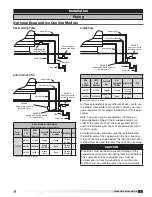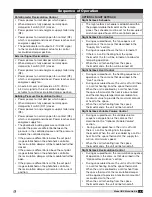
Model IGX Make-Up Air
28
®
1. Check Electrical Connections
Tug test all internal electrical connections to ensure no
loose connections occurred during shipment.
2. Check Voltage
Before starting the unit, compare the supplied voltage,
hertz, and phase with the unit and motor(s) nameplate
information.
3. Check the Fan Rotation
Open the fan access door and run the fan momentarily
to determine the rotation. If the fan is rotating in the
wrong direction, the unit will move some air, but will
not perform as designed. Be sure to perform a visual
inspection to guarantee the correct fan rotation. Refer
to the arrows to indicate the proper direction. To reverse
the rotation of a three phase units, disconnect and lock-
out the power, then interchange any two motor leads. To
reverse the rotation of a single phase units, disconnect
and lock-out the power, then rewire the motor per the
manufacturer’s instructions.
Supply Fan
Start-Up
4. Check for Vibration
Check for unusual noise, vibration or overheating of the
bearings.
Excessive vibration may be experienced during the
initial start-up. Left unchecked, it can cause a multitude
of problems including structural and/or component
failure.
Generally, fan vibration and noise is transmitted to other
parts of the building by the ductwork. To minimize this
undesirable effect, heavy canvas duct connectors can
be used.
5. Motor Check
Measure the motor’s voltage, amps and RPM. Compare
to the specifications. Motor amps can be reduced
by lowering the fan RPM or increasing system static
pressure.
Additional starters and overloads may be provided in
the make-up air control center for optional external
exhaust fans. Exhaust fan motor voltage must match
unit nameplate voltage. Exhaust fan overloads must
be set to exhaust fan motor Full Load Amps (FLA).
Reference the exhaust fan manual for additional
information.
6. Air Volume Measurement
To ensure accuracy, the dampers are to be open when
measuring the air volume.
Measure the unit’s air volume and compare it with
it’s rated air volume. If the measured air volume is
incorrect, adjust the fan’s RPM by adjusting the variable
pitch sheave, if equipped, or replacing the sheave(s) if
necessary. Direct drive fan RPM must be adjusted by
changing VFD parameters. Consult factory for more
information.
The most accurate way to measure the air volume is by
using a pitot traverse method downstream of the fan.
Changing the air volume can significantly increase the
motor’s amps. If the air volume is changed, the motor
amp draw must be checked to prevent overloading the
motor.
7. Optional VFD
If unit is equipped with VFD, verify if VFD is provided
for a soft start/air balance in a constant volume
configuration or used as variable volume to vary the
supply fan speed. If unit is intended for variable volume,
reference
Sequence of Operation, Optional Variable Air
Volume
section in this IOM for more information.
Forward-Curved Fan Rotation
Mixed Flow Plenum Rotation
(Always counterclockwise as viewed from inlet)
Backward-Curved Plenum Rotation
(May be clockwise or counterclockwise as viewed from inlet)
















































